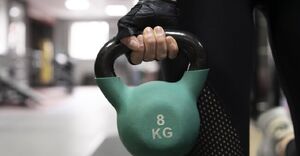
The Family Guide to Kettlebell Training: Sizes and Weights for Every Age
Looking for a fun and effective way to stay active as a family?
Kettlebell training might be the perfect solution!
In this comprehensive guide, we will explore the benefits of kettlebell training for families, including building strength, improving cardiovascular health, enhancing coordination, and promoting family bonding.
We will also discuss the different sizes and weights of kettlebells available, as well as how to choose the right kettlebell size based on age.
Covering important safety measures to ensure a safe and enjoyable kettlebell training experience for the whole family.
Let’s dive in and discover the world of kettlebell training together!
What Is Kettlebell Training?
Kettlebell training is a form of exercise that involves the use of kettlebells, which are cast-iron or steel weights with a handle attached. This dynamic and versatile workout tool offers a wide range of exercises that target various muscle groups and improve overall fitness levels.
The history of kettlebell training can be traced back to Ancient Greece, where it was used by athletes and soldiers to enhance their physical prowess. Today, kettlebell training has gained popularity in the fitness industry due to its effectiveness in improving strength, cardiovascular health, and flexibility.
One of the core principles of kettlebell training is its focus on compound movements that engage multiple muscle groups simultaneously, leading to functional strength gains. Unlike traditional weightlifting, kettlebell exercises often incorporate ballistic movements, which can help improve coordination, agility, and endurance. This emphasis on functional fitness makes kettlebell training a valuable addition to any workout regimen.
What Are The Benefits Of Kettlebell Training For Families?
Family kettlebell training offers a unique opportunity for all family members to engage in a fun and effective fitness routine together. It promotes a healthy lifestyle, encourages physical activity, and strengthens family bonds through shared workouts.
By incorporating kettlebell training into your family fitness routine, you not only benefit from improved cardiovascular health and muscle strength but also create a sense of unity and teamwork among family members. Setting fitness goals together can boost motivation and accountability, leading to more consistent workouts. Sharing this experience can lead to healthier habits being passed down to younger generations, instilling a lifelong appreciation for staying active and fit as a family.
Builds Strength and Endurance
Kettlebell training is highly effective in building both strength and endurance by engaging multiple muscle groups simultaneously. This full-body workout routine enhances overall strength levels and improves muscular endurance for better performance in daily activities.
Incorporating exercises like kettlebell swings, which engage the lower body and core muscles, can help improve balance and coordination. Similarly, kettlebell squats target the quadriceps, hamstrings, and glutes, aiding in lower body strength development. Kettlebell presses and rows are excellent for strengthening the shoulders, arms, and back, promoting better posture and reducing the risk of injury. Strength training with kettlebells is suitable for individuals of all ages, offering a scalable workout option that can be tailored to different fitness levels within a family setting.
Improves Cardiovascular Health
Kettlebell training plays a significant role in improving cardiovascular health through dynamic movements like kettlebell swings. These exercises elevate heart rate, enhance circulation, and boost endurance, contributing to better heart health for the whole family.
Incorporating kettlebell swings and other dynamic movements into family workout routines not only benefits individual family members but also strengthens the familial bond through shared physical activity. By engaging in regular cardiovascular training together, families can create a positive environment that promotes healthy habits and encourages everyone to prioritize their wellbeing.
Over time, the cumulative effects of consistent kettlebell exercises can lead to reduced risk of heart disease, improved stamina, and a more active lifestyle for every member of the family.
Enhances Coordination and Balance
Kettlebell training enhances coordination and balance by requiring controlled movements and engaging core muscles throughout the exercises. Improving core strength and stability leads to better coordination and balance for family members of all ages.
Practicing kettlebell exercises can benefit individuals in different ways depending on their fitness levels. For beginners, simpler movements like the kettlebell swing or goblet squat can help in establishing a solid foundation of balance and coordination. Intermediate users may progress to more complex exercises such as the Turkish get-up or windmill, which challenge coordination while requiring core stabilization. Advanced family members can incorporate single-arm kettlebell exercises like the snatch or clean and press to enhance their coordination and balance at higher skill levels.
Promotes Family Bonding
One of the key benefits of family kettlebell training is the promotion of family bonding through shared physical activities. Engaging in fun and challenging workouts together fosters a sense of unity and teamwork among family members, creating lasting memories and stronger familial connections.
It is essential to consider the varying fitness levels within the family when planning these workout sessions. By tailoring exercises to accommodate different capabilities, each family member can actively participate and feel included. This inclusivity not only enhances physical health but also cultivates a supportive environment where family members can motivate and cheer each other on. Such mutual support not only boosts individual fitness progress but also reinforces the familial bond, ultimately creating a positive atmosphere for shared wellness goals.
What Are The Different Sizes And Weights Of Kettlebells?
Kettlebells come in various sizes and weights to accommodate different fitness levels and workout intensities. Understanding the distinctions between light, medium, heavy, and extra heavy kettlebells is crucial for selecting the appropriate equipment for effective training.
Light kettlebells typically range from 5 to 15 pounds and are great for beginners or individuals focusing on higher repetitions and endurance.
Medium kettlebells usually weigh between 15 to 25 pounds, catering to those looking to build strength and muscle mass.
Moving up, heavy kettlebells can range from 25 to 35 pounds providing a more intense challenge for experienced users.
For the ultimate test, extra heavy kettlebells, weighing over 35 pounds, are designed for advanced lifters seeking to push their limits and surpass fitness plateaus.
Light Kettlebells (4-8 kg)
Light kettlebells, typically ranging from 4 to 8 kg, are ideal for beginners and individuals focusing on introductory kettlebell training. These weights offer a manageable starting point for developing proper form and technique before progressing to heavier kettlebells.
It is crucial for those starting out with light kettlebells to concentrate on mastering fundamental exercises like swings, squats, and Turkish get-ups to build a strong foundation.
Beginners should prioritize learning the correct movement patterns and ensuring proper alignment to prevent injury and maximize the effectiveness of their workouts.
As strength and skill levels improve, individuals can gradually increase the weight of the kettlebell to continue challenging themselves without compromising on form.
This gradual progression is key to safely advancing in kettlebell training and achieving long-term fitness goals.
Medium Kettlebells (10-16 kg)
Medium kettlebells, typically weighing between 10 and 16 kg, cater to intermediate users seeking a balance between challenge and manageability in their kettlebell exercises. These weights allow for progression in strength and skill development.
By using medium kettlebells, individuals can enhance their overall fitness level through a wide variety of exercises, including swings, Turkish get-ups, snatches, and presses. This variety helps target different muscle groups and improves overall coordination and stability. Structuring a workout with medium kettlebells can involve a combination of strength training, cardiovascular conditioning, and flexibility work.
For instance, incorporating circuits with different exercises can ensure a well-rounded workout that promotes both strength and endurance. It’s important to gradually increase the intensity and duration of the workouts to continue challenging the body effectively.
Heavy Kettlebells (18-24 kg)
Heavy kettlebells, typically ranging from 18 to 24 kg, are suitable for advanced users looking to challenge their strength and endurance levels with more demanding kettlebell techniques. These weights provide an intense workout experience for experienced kettlebell enthusiasts.
Mastering heavy kettlebells requires a gradual progression in both strength and technique, ensuring proper form to prevent injury and maximize results.
Advanced users can benefit from exercises like the double kettlebell snatch or the Turkish get-up, which target multiple muscle groups and enhance overall functional strength.
Tailored training programs for heavy kettlebells often incorporate interval training, complexes, and supersets to push users beyond their limits and promote continuous growth in strength and conditioning.
Extra Heavy Kettlebells (28+ kg)
Extra heavy kettlebells, weighing 28 kg or more, are reserved for highly advanced users seeking maximum resistance and challenge in their kettlebell programs. These weights are designed for elite athletes and dedicated individuals looking to push their limits.
Utilizing extra heavy kettlebells in workouts requires a meticulous approach to ensure safety and effectiveness. Specialized training programs focusing on strength and form are essential when incorporating these heavier weights. It is crucial to gradually progress to higher weights to prevent injuries and improve performance. Proper technique, such as maintaining a strong grip and stable stance, is paramount when using extra heavy kettlebells. Incorporating adequate rest periods and listening to the body’s signals to avoid overtraining are key safety tips for advanced practitioners.
How To Choose The Right Kettlebell Size For Your Age?
Selecting the appropriate kettlebell size based on age is crucial to ensure safe and effective workouts for individuals of all age groups. Tailoring the kettlebell weight to suit different age categories helps optimize training outcomes and prevent injuries.
For children and teens, it is recommended to start with lighter kettlebells to focus on learning proper form and technique before gradually increasing weight.
Adults can typically handle heavier kettlebells based on their fitness level and strength, but it is still essential to choose a weight that challenges without causing strain.
Seniors should opt for lighter kettlebells to prioritize safety and joint health, adjusting as needed to accommodate any physical limitations.
Regardless of age, supervision from a trained instructor is crucial when introducing kettlebell training to ensure proper execution and minimize the risk of injury.
Children (Ages 5-12)
When introducing children to kettlebell training, it is essential to select age-appropriate kettlebell sizes and weights to match their developmental stage and physical abilities. Lighter kettlebells with proper supervision can help children engage safely and effectively in fitness activities.
By incorporating kettlebell training into children’s fitness routines, not only do they get a great workout, but they also enhance their coordination and balance. Structuring fun and engaging kettlebell sessions can involve incorporating games and challenges that encourage movement and exploration.
For instance, setting up an obstacle course that includes kettlebell exercises can make the training session more interactive and enjoyable for kids. Adding music or creating a reward system can also motivate children to participate enthusiastically in their kettlebell workouts.
Teens (Ages 13-19)
Teens can benefit from kettlebell training by using appropriate kettlebell sizes and weights that match their physical development and fitness goals. Engaging in kettlebell exercises designed for teens promotes strength, coordination, and overall fitness in this age group.
It is crucial for teenagers to focus on maintaining proper form and technique when incorporating kettlebell training into their fitness routines. This ensures that they not only reap the benefits of strength and coordination but also minimizes the risk of potential injuries.
Recommended kettlebell exercises for teenagers include kettlebell swings, goblet squats, and Turkish get-ups, as these movements target multiple muscle groups and help in developing functional strength. By following a well-rounded kettlebell routine tailored to their fitness levels and interests, teenagers can enhance their physical abilities and overall well-being.
Adults (Ages 20-64)
Adults can leverage the benefits of kettlebell training across different age ranges by selecting appropriate kettlebell sizes and weights for their fitness levels. Engaging in regular kettlebell workouts enhances strength, cardiovascular health, and overall physical well-being for adults.
Kettlebell training offers adults the versatility to optimize their workout routines with exercises that not only target specific muscle groups but also enhance overall functional fitness. By incorporating dynamic movements like swings, snatches, and Turkish get-ups, adults can improve their coordination, balance, and flexibility. Kettlebell training is known for its efficient calorie-burning potential, making it a beneficial tool for weight management and body composition goals.
Seniors (Ages 65+)
Seniors can engage in safe and beneficial kettlebell training by choosing lighter kettlebell sizes and weights that suit their age-related physical capabilities and health considerations. Incorporating kettlebell techniques tailored to seniors promotes mobility, balance, and overall well-being.
It is essential for seniors to focus on gentle movements and proper warm-up routines before starting their kettlebell workout sessions. This approach helps in preventing strain and injuries, allowing seniors to fully enjoy the benefits of kettlebell exercises. Gradual progression is key in kettlebell training for seniors, as it allows them to build strength and endurance over time without overexerting themselves. The positive impact of kettlebell exercises on senior health and vitality is notable, as it helps in improving muscle tone, bone density, and cardiovascular health.
What Are The Safety Measures For Families Doing Kettlebell Training?
Ensuring safety during family kettlebell training sessions involves adhering to essential guidelines, such as proper warm-up and cool-down routines, maintaining correct form and technique, and selecting the appropriate kettlebell size for each family member to prevent injuries.
It is crucial to emphasize the importance of gradually increasing the intensity and weight of the kettlebell workouts to allow for physiological adaptations and minimize the risk of overexertion.
Encouraging family members to listen to their bodies, take breaks when needed, and stay hydrated throughout the session are simple yet effective measures that can contribute to a safer training experience.
Having a knowledgeable and experienced individual supervise the workouts can provide valuable feedback on form, offer modifications, and ensure that everyone is performing exercises correctly to reduce the likelihood of injuries.
Proper Warm-Up and Cool-Down
Effective warm-up and cool-down routines are essential components of safe kettlebell training for families. Prioritizing proper warm-up exercises prepares the muscles for activity, while incorporating a thorough cool-down helps prevent muscle soreness and promotes recovery.
Dynamic stretches in the warm-up phase can include movements such as leg swings, arm circles, and torso twists to increase blood flow and flexibility. Mobility drills like hip openers and shoulder rotations can enhance joint range of motion, reducing the risk of strains during kettlebell workouts.
For the cool-down segment, encourage gentle stretching and foam rolling to aid in muscle relaxation and reducing tension. Incorporating relaxation techniques like deep breathing or gentle yoga poses can help calm the body and mind post-workout.
Correct Form and Technique
Maintaining proper form and technique is paramount during kettlebell training to prevent injuries and ensure effective workout outcomes for families. Focusing on mastering correct movement patterns and technique execution enhances the safety and efficacy of kettlebell exercises.
When performing kettlebell swings, it is crucial to engage your core muscles and maintain a neutral spine throughout the movement. Avoid the common mistake of using only your arms to lift the kettlebell; instead, initiate the swing with a powerful hip hinge. Keeping your shoulders relaxed and away from your ears can help prevent unnecessary tension. Remember to exhale forcefully on the way up and inhale as you bring the kettlebell back down. By following these visual cues and focusing on maintaining proper alignment, family members can optimize their kettlebell workout experience.
Gradual Progression
Implementing gradual progression in kettlebell training ensures that family members can improve their fitness levels safely and effectively over time. By gradually increasing intensity, volume, or complexity, individuals can challenge themselves while minimizing the risk of overexertion or injury.
This approach allows each family member to tailor their workouts to their specific needs and goals, whether it be building strength, improving endurance, or enhancing overall fitness.
To structure progressive routines, start by determining individual baseline levels and establishing realistic goals. It’s important to monitor progress regularly by tracking weights lifted, repetitions completed, and overall performance. Adjust the intensity as needed to ensure continued growth and prevent plateaus in training.
By keeping the workouts engaging yet manageable, family members can enjoy the benefits of kettlebell training while steadily progressing towards their desired fitness outcomes.
Supervision and Instruction
Having proper supervision and instruction during family kettlebell training sessions is essential for ensuring safe and effective workout experiences. Qualified instructors or experienced individuals can offer guidance on kettlebell skills, technique corrections, and workout modifications tailored to each family member’s needs.
They play a crucial role in not only demonstrating proper form and movements but also in providing feedback and motivation to keep family members engaged and progressing. By supervising the sessions, instructors can ensure that everyone is using kettlebells safely to prevent injuries. They can help beginners gradually increase the intensity of their workouts while focusing on correct breathing techniques and muscle engagement.




No Comments